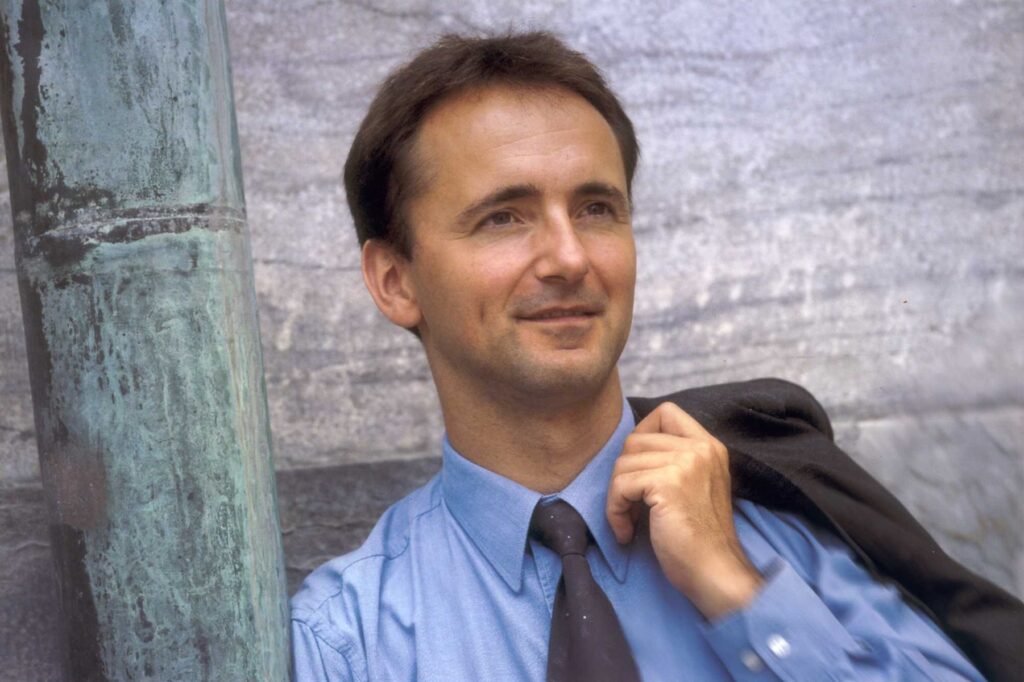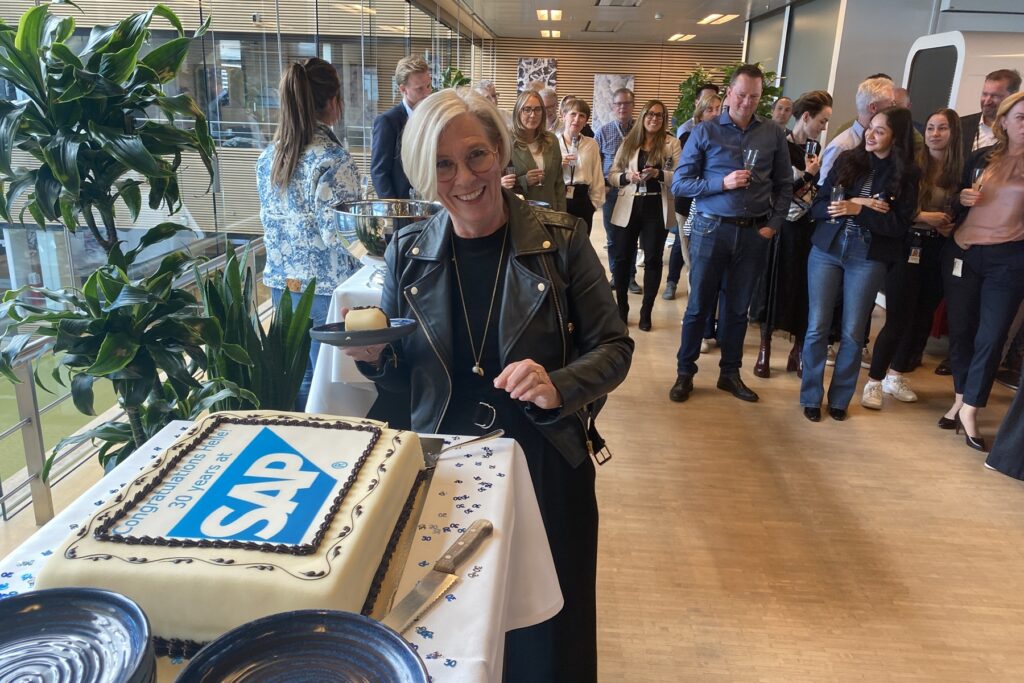Helle Dochedahl, managing director of the SAP Nordic & Baltic region, and former SAP Co-CEO Jim Hagemann Snabe look back on over 35 years of SAP in the Nordic countries — and reveal the story of how one of the first SAP R/3 customers there went live.
Helle Dochedahl and Jim Hagemann Snabe met in the mid-1980s while they were both studying in Aarhus, Denmark. They didn’t know it back then, but that wouldn’t be the last time that their paths crossed. In 1993, they met again.
At the time, Snabe was consulting manager at SAP in Denmark, having joined the company three years before as a trainee straight out of university. “Back then, SAP was on a big push to expand its business internationally and was hiring young people from around the world. It spent a year training them in Walldorf and then sent them back to their home countries,” says Snabe.
With a year in Walldorf under his belt, he returned to SAP Denmark in April 1991, joining its 25 other employees, half of whom were consultants. A few months later, he was asked if he wanted to take over as consulting manager. “I was 24, and the youngest guy there, but after my year in Germany, I had a strong and solid understanding of the systems. Being entrusted so soon with responsibilities like this helped employees grow and was characteristic of SAP’s culture.”
In 1993, Snabe was looking to expand his team of consultants. Dochedahl, meanwhile, was working at a small Danish ERP company. She recalls: “I had just had my first son and was on parental leave when I saw the job posting in the newspaper. I had already heard quite a lot about SAP from Snabe and some other friends from university, so it got me thinking.”
At the time, Dochedahl was living in Aarhus with her husband, who also works in the IT industry. But in 1988, SAP had chosen Denmark’s capital city as the base for its Danish business.
“If you wanted to make it in IT, you had to go to Copenhagen,” says Dochedahl. She first called her mother, who agreed to help out with childcare. Then she called Snabe, who hired her on the spot. But there was one condition that he had to agree to: “I couldn’t and wouldn’t leave my son to spend several months training in Walldorf. So I taught myself most of the things that I needed to know, and every so often, I would head to Walldorf for a week.”
When she joined the company in 1993, Dochedahl did not have much to do with the SAP R/2 mainframe program. SAP R/3, the company’s new client-server software, had launched the year before. And it was with SAP R/3 that the small Danish subsidiary would make history.
Early Days in the Nordics
Let’s rewind for a moment. From 1987 onwards, SAP was making a name for itself in the Nordics through its marketing and sales initiatives and customer workshops. Joergen Oestergaard, who was managing director of SAP’s Nordic business from its very beginnings in early 1987, created the first business plan for the markets there.
Since the first SAP R/2 systems were quick to sell and implement, and interest among other companies was growing steadily, SAP management and SAP International decided to set up the first subsidiaries in Nordic countries.
In Sweden, SAP Svenska AB opened its doors in February 1988. The Danish office, SAP Danmark A/S, followed a month later. Into the 1990s, it also served customers in Norway, with the Swedish office supporting those in Finland until the end of that decade. From 1984, SAP International, located in Biel, Switzerland, ran SAP’s international business and spearheaded the company’s global expansion.
The person in charge was managing director Hans Schlegel. Schlegel was there when, in April 1988, everyone from SAP Denmark and SAP Sweden met at a hotel in a ski resort north of Oslo for a five-day Nordic kickoff meeting. They were joined by employees of A/S EDB (Electronic Data Processing), a Norwegian IT company that had by then been operating in the market for 25 years and would partner SAP to help sell the SAP R/2 system and translate it into Norwegian. At the Hotel Storefjell meeting, they worked out how best to coordinate activities, shared their experiences, and learned from each other.
Following that meeting, both subsidiaries went on to flourish. In 1992, for example, SAP Sweden was already generating around $3.6 million (around 30 million Swedish krona) in revenue. And its list of customers included the Swedish national rail operator SJ (Statens Järnvägar), Ericsson Business Communications, and Skandinaviska Enskilda Banken (SEB) as well as some subsidiaries of German companies.
Reinvention at the Right Time
Jim Hagemann Snabe first encountered SAP R/3 in 1991, and he and the team at SAP Denmark then “began to sell the vision of SAP R/3 to Nordic customers” — even though the product wouldn’t officially launch until July 1992.
One of the customers that had already implemented SAP R/2 was Finnish chemical company Kemira, which was headquartered in Copenhagen at that time.
As SAP Co-Founder Hasso Plattner recalls in his book Anticipating Change, implementing SAP R/2 at Kemira, a “UNIX company,” had been “painful.” So, he promised them that, “as soon as we have a UNIX system, we’ll replace your system.”
In the summer of 1992, that day arrived: Snabe and his team won a new SAP R/3 customer for SAP, and, according to Helle Dochedahl, Kemira became “the first customer outside Austria, Germany, and Switzerland to go live with SAP R/3.” Though Dochedahl wasn’t working for SAP at that time, she recalls that, when she later visited Kemira: “They told me the story themselves and how proud they were of being first movers and daring to go for it.”
While visiting Kemira, Dochedahl made a discovery of her own: “I spotted some land for sale opposite the Kemira office. We bought a plot and built a house on it, and I’ve lived there ever since. That was 28 years ago now.”
Jim Hagemann Snabe sees the successful implementation of SAP R/3 at Kemira and at other customers in the Nordic countries and around the world from a different angle. “At that time, SAP was doing very well with SAP R/2. But rather than simply reap the rewards, it decided to invest heavily in the next generation of solutions. I believe that is partly why SAP is still one of only a small number of European IT companies that are successful. SAP has always been able to reinvent itself from a position of strength, instead of waiting – like many of its competitors – until it’s almost too late.”
Who’s Who
Helle Dochedahl celebrated 30 years at SAP in April 2023. “I was ‘born’ with SAP R/3,” she says, and reflects on the many other milestones in her own SAP story. She has fond memories of the many companies – including Arla, Carlsberg, and Velux – that she worked with and learned from during her early years in presales. “I have been very fortunate to work in many different areas, such as presales, education, and now sales. And I’ve served as COO. The various positions I’ve held have allowed me to adapt my career depending on where I was in my life and what my personal wishes were. What I love about SAP is that you can always raise your hand and there are development opportunities for all life stages.”
When asked why she has stayed with SAP for so long, she says: “You stay with a company that makes you feel good! It is the combination of great colleagues, the important job we do for our customers, and the opportunity to always try new things that creates the magic.”
—
Jim Hagemann Snabe started at SAP as a trainee in 1990 and worked as a consulting manager before moving to IBM in October 1994. In January 1997, he returned to SAP to become the country manager for its market unit in Sweden. Having held a number of leadership positions in sales, services, and development, in July 2008 he was appointed to the SAP Executive Board as the member in charge of innovation and product development. In February 2010, he was appointed co-CEO alongside Bill McDermott. After he retired from the SAP Executive Board in 2014, Snabe served as a member of the SAP Supervisory Board until July 2017.
Today, Snabe holds a number of positions, including chairperson of the supervisory boards at Siemens and Northvolt.
—
Kemira is a global leader in sustainable chemical products for water-intensive industries. It primarily serves customers in the pulp and paper, water treatment, and the energy industries. Recently, Kemira has not only transformed its existing SAP ERP, it has also rebuilt its entire global process and system landscapes on SAP intelligent enterprise architecture. The transformation program saw five dovetailed initiatives implemented simultaneously during a 15-month period: an SAP S/4HANA transformation, a redesign of financial accounting processes, adoption of SAP Datasphere as the enterprise data warehouse, a digital data excellence initiative, and a full migration of 360 on-premise interfaces to SAP Integration Suite.
Kemira has 5,000 employees and, in 2022, generated around €3.6 billion in revenue. It sells its solutions in more than 100 countries.





